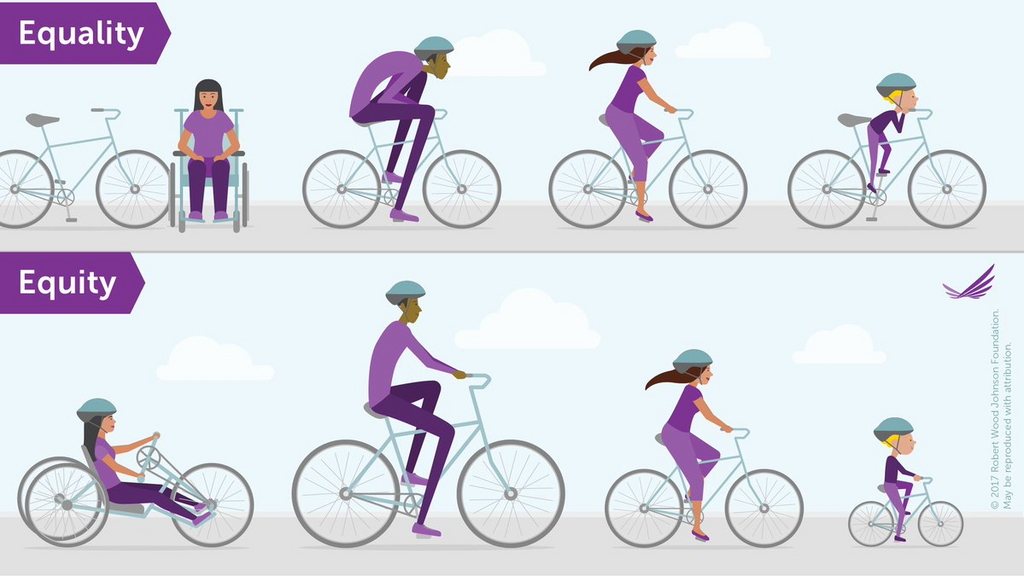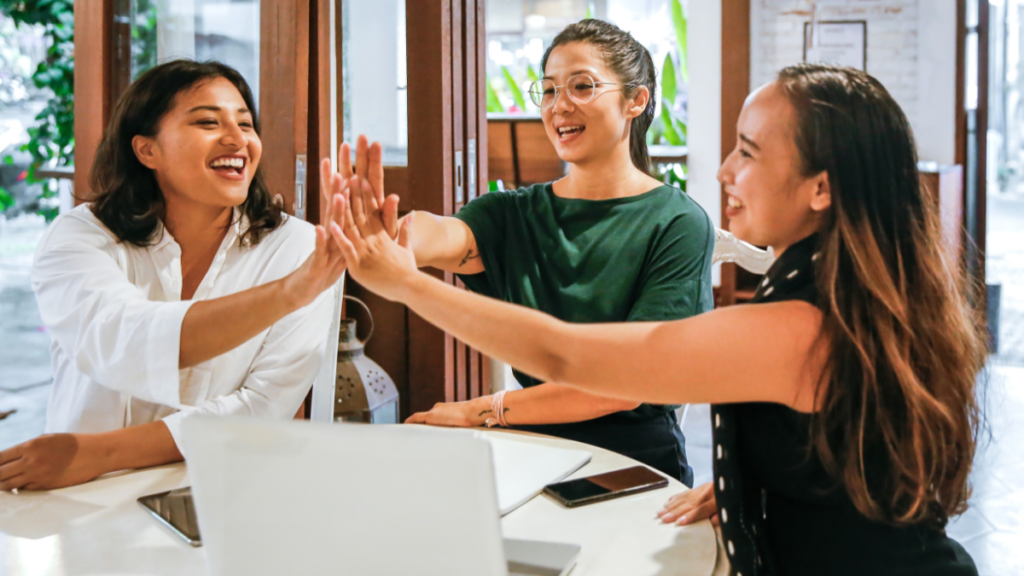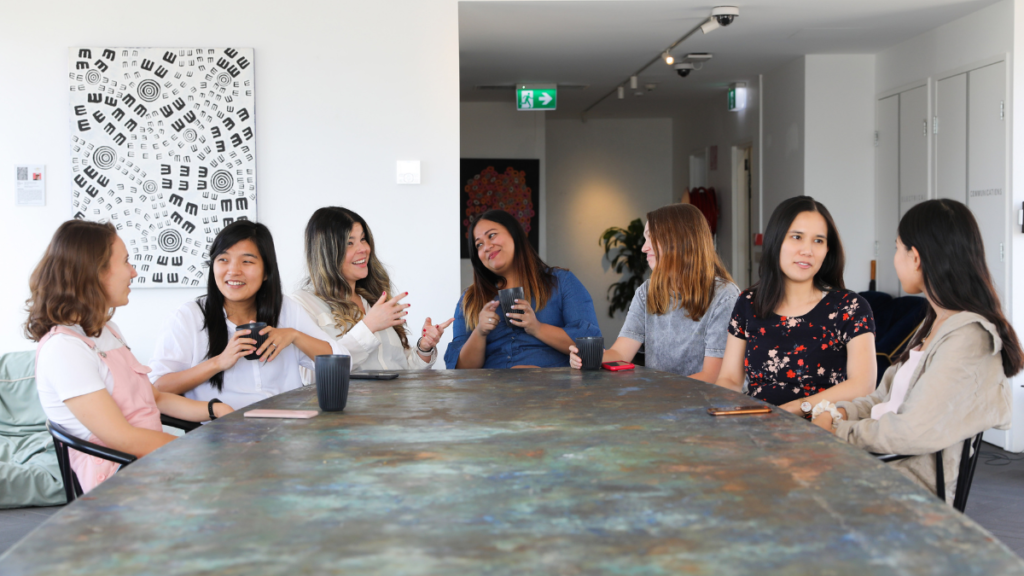On the 8th of March each year, the world recognises women for International Women’s Day. This day celebrates women’s accomplishments in areas such as culture, politics, economics, and society. Each year has a theme and 2023’s theme is to #EmbraceEquity, meaning that equity is a must-have for all. The theme’s focus is on how gender equity needs to be sewn into the fabric of societal DNA. So, what is International Women’s Day and why is it so important?

What’s the difference between equality and equity?
Equality means giving the same resources and opportunities to all. Everyone has the same thing! But equity recognises that every person’s circumstances differ which means that each person may need different resources and opportunities to reach an equal outcome. Here’s a graphic from the International Women’s Day organisation’s website.

It explains that giving everyone the exact same bike would make them equal but that bike doesn’t meet their individual needs and circumstances. In this example, one woman is disabled and needs an adapted bike; another girl is only a child and needs a smaller bike; a third woman has exactly what she needs; and the man needs a larger bike! Equity means that even if each of these people is given different equipment (i.e. different types of bikes, adapted for their specific needs), they now each have an equal opportunity to go for a bike ride! Equality would mean they’d all get the same bike but as the graphic demonstrates, that doesn’t solve the problem or provide equal opportunity.
Of course, the bike is a metaphor and in society, those adaptations look different. We are slowly starting to get to a place of equity for women and hopefully this year’s mission will take that further.

Why do women’s equity and equality still matter?
A 1950s home economics book page took the internet by storm for its outmoded pieces of advice including how being a perfect wife meant having dinner on the table to show your appreciation, never complaining or talking about your problems, making sure you and your children looked perfect for when your husband came home, keeping the home tidy and neat, and generally subverting all your needs and feelings for those of your husband. Of course, in the modern light, this overt sexism is obvious to us but there are still many phrases and sexist overtones in our century that we haven’t entirely erased, even since the early half of the twentieth century.
Questions women face such as do you want children, why don’t you want children, comments on their appearance and dress, questioning their knowledge and expertise at work, asking if they need help with something, questioning if women can balance work and home life, asking how someone can leave their children on a night out, or even questioning if dad is okay “babysitting” (i.e. parenting) the kids. Even in the workplace, women face gender discrimination and are passed up on promotions or unfairly subjugated because they often provide most of the childcare. And even if a young woman is childfree, she may face comments about how she may be of childbearing age and leave her role. A study of 3,001 working adults demonstrated that 74% of women are the main carers for their children and have had to take time off work to care for their children, whereas only 26% of men are. Furthermore, women are less likely to be promoted after having children; some of this reason may be due to choice as women prioritise family over career but that’s not always the case.
On a broader scope, the UN notes that 70% of the world’s 1.3 billion people are women in poverty. Poverty disproportionately impacts women worldwide. 80% of these women and children are displaced because of climate disasters.

When did International Women’s Day begin?
Today, International Women’s Day is a global celebration of women, gender rights, and gender equality. But it had interesting beginnings.
In 1908, 15,000 women marched through New York City in protest, demanding shorter working hours, better pay, and voting rights. In 1909, the Socialist Party of America launched its first National Woman’s Day (NWD) across the United States on the 28th of February. Women continued to celebrate National Women’s Day on the last Sunday of February until 1913.
International Women’s Day originated as part of a labour and voting rights movement in 1910. During the second International Conference of Working Women in Copenhagen, the leader of the Women’s Office for the Social Democratic Party in Germany, Clara Zetken, proposed the idea of an International Women’s Day where women could be celebrated in every country on the same day to press for their demands. The one-hundred women present, from seventeen countries, representing unions, socialist parties, working women’s clubs, and even the first three women elected to the Finnish parliament, agreed unanimously.
The first International Women’s Day was celebrated on the 19th of March 1911 in Austria, Denmark, Switzerland, and Germany. More than one million women and men attended IWD rallies, campaigning for women’s right to work, to vote, to be trained, to hold public office, and to end discrimination.
1n 1913 to 1914, different days were observed in different countries and it was decided that the 8th of March would become the official date. In London on that day in 1914, there was a march from Bow to Trafalgar Square in support of women’s suffrage.
International Women’s Day was celebrated for the first time by the United Nations in 1975. In 1996, the yearly themes for International Women’s Day began. The first official theme was “Celebrating the past, Planning for the Future.”
It’s now a national holiday in twenty-seven countries, often marked by men acknowledging women who are significant in their lives via flowers and small gifts.
Other countries organised rallies, parades, and conferences.

How can I get involved and celebrate International Women’s Day?
- You can search the event’s tab under “Get Involved” on the International Women’s Day website. There you can filter by country and city to find events near you. There are over 25 UK-based cities listed on the website that are hosting events but you can also filter by virtual events.
- You can host your own event. Sign up for an event pack here. Whether you simply gather your closest girlfriends and host a tea or hold a panel discussion, it’s a great way to celebrate women.
- You can create a pledge wall at work where each person pledges to help forge a more gender-equal world. Some ideas are writing down things like “I will value women’s contributions and achievements.” “I will be aware of any bias and assumptions I make about women.” “I will notice and question when women are not present or equal.” And so on. You can find pledge cards in the event pack. Add the #IWD2023 and #IWDpledgewall hashtags to your social media pages to promote your efforts.
- Simply celebrate a woman who is special to you whether that’s your grandmother, wife, mother, daughter, friend, colleague, and so forth.
- Fundraise for female-focused charities or support female-led and owned businesses.
- Create a virtual “Women’s History Month” trivia game. International Women’s Day is held during Women’s History Month. Find out more here.
- Research an influential woman in history and share her story with a new audience (i.e. your child, niece/nephew, friend, etc).
- Watch a film or documentary pertaining to women’s history or an influential female historical figure.
- Have a coffee date with a woman in your network.
- Go to a museum or art installation from a female artist or buy a book by a female author.
There are many ways you can celebrate women on International Women’s Day – and every day – in big and small ways.

The takeaways
Get involved in an International Women’s Day event by visiting their website here. Share with us on Tria Beauty UK’s Facebook or Instagram pages how you plan to get involved this year. Don’t forget to post about it on your social media and tag Tria Beauty UK at #TriaBeautyUK as well as #IWD2023.
